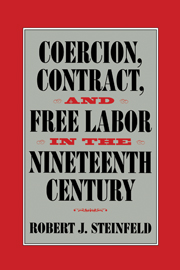Book contents
- Frontmatter
- Contents
- List of Illustrations and Tables
- Acknowledgments
- Introduction: Free Wage Labor in the History of the West
- PART ONE AMERICAN CONTRACT LABOR AND ENGLISH WAGE LABOR: THE USES OF PECUNIARY AND NONPECUNIARY PRESSURE
- 1 “Free” Contract Labor in the United States: An Anti-essentialist View of Labor Types I
- 2 “Unfree” Wage Labor in Nineteenth-Century England: An Anti-essentialist View of Labor Types II
- 3 Explaining the Legal Content of English Wage Labor
- 4 Struggles over the Rules: The Common Law Courts, Parliament, the People, and the Master and Servant Acts
- 5 Struggles under the Rules: Strategic Behavior and Historical Change in Legal Context
- 6 Struggles to Change the Rules
- 7 Freedom of Contract and Freedom of Person
- PART TWO “FREE” AND “UNFREE” LABOR IN THE UNITED STATES
- Conclusion
- Index
7 - Freedom of Contract and Freedom of Person
Published online by Cambridge University Press: 06 July 2010
- Frontmatter
- Contents
- List of Illustrations and Tables
- Acknowledgments
- Introduction: Free Wage Labor in the History of the West
- PART ONE AMERICAN CONTRACT LABOR AND ENGLISH WAGE LABOR: THE USES OF PECUNIARY AND NONPECUNIARY PRESSURE
- 1 “Free” Contract Labor in the United States: An Anti-essentialist View of Labor Types I
- 2 “Unfree” Wage Labor in Nineteenth-Century England: An Anti-essentialist View of Labor Types II
- 3 Explaining the Legal Content of English Wage Labor
- 4 Struggles over the Rules: The Common Law Courts, Parliament, the People, and the Master and Servant Acts
- 5 Struggles under the Rules: Strategic Behavior and Historical Change in Legal Context
- 6 Struggles to Change the Rules
- 7 Freedom of Contract and Freedom of Person
- PART TWO “FREE” AND “UNFREE” LABOR IN THE UNITED STATES
- Conclusion
- Index
Summary
The traditional account of the rise of free labor is backwards. The advent of freer markets in England during the late eighteenth and nineteenth centuries did not produce “free labor,” but rather, by modern standards, a form of “coerced” contractual labor, similar to, although less harsh than, the contract labor used in the colonial periphery. For English elites who worked to make markets freer during this period, penal sanctions were an integral aspect of reform, guaranteeing that markets organized on the basis of private agreements would function properly. When they possessed the political power to do so, the English employing classes enacted and used penal sanctions to enforce the contracts of wage workers. It was only as a result of the greatly increased power of labor later in the nineteenth century that the regime of contract rules we refer to as modern free labor was fought for and enacted into law.
Modern free labor in England must be seen as a product of labor's struggle to improve its position in a market society. In general, labor pursued three broad strategies of legal reform, which admittedly were not always consistent with one another. First, labor worked to enact rules that would increase its bargaining power by giving it legal permission to engage collectively in a broader range of activities designed to bring employers to terms. Second, labor supported rule changes that would improve the main alternatives to wage labor by establishing, for example, social insurance programs, unemployment compensation, and old age pensions. Third, labor also supported efforts to restrict freedom of contract in certain areas through the passage of, for example, maximum hours and minimum…
- Type
- Chapter
- Information
- Coercion, Contract, and Free Labor in the Nineteenth Century , pp. 234 - 250Publisher: Cambridge University PressPrint publication year: 2001
- 1
- Cited by



